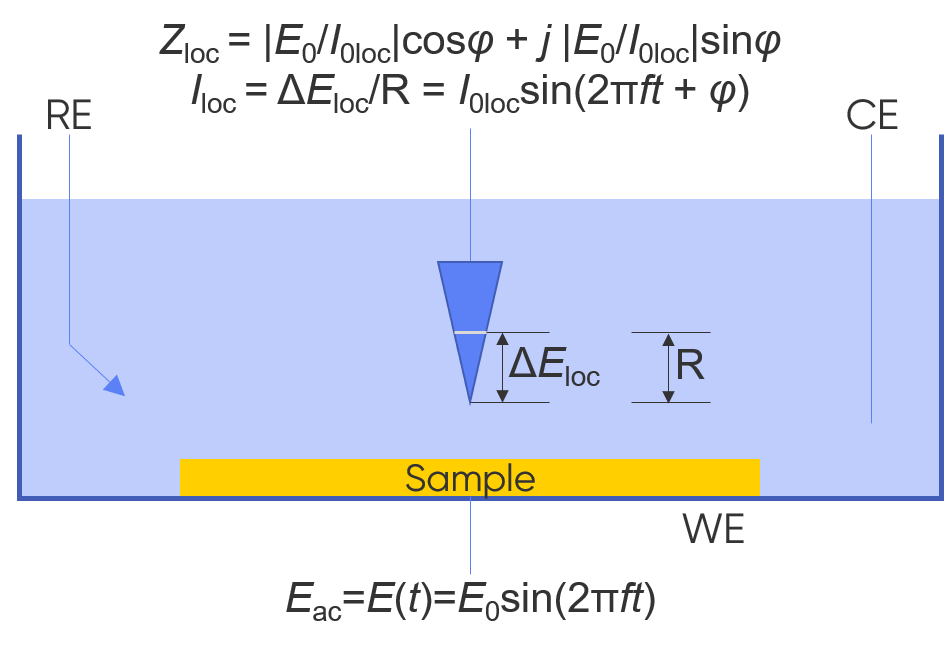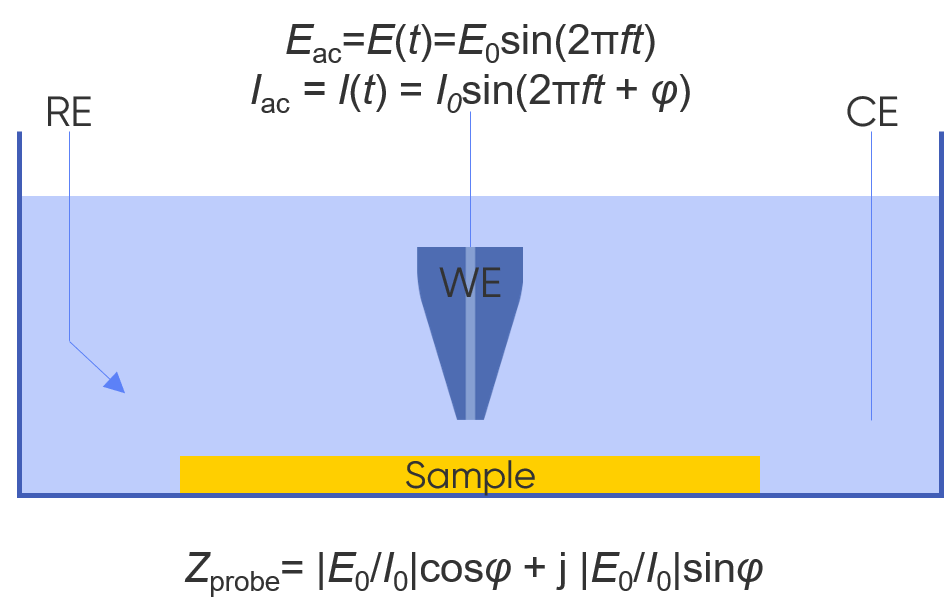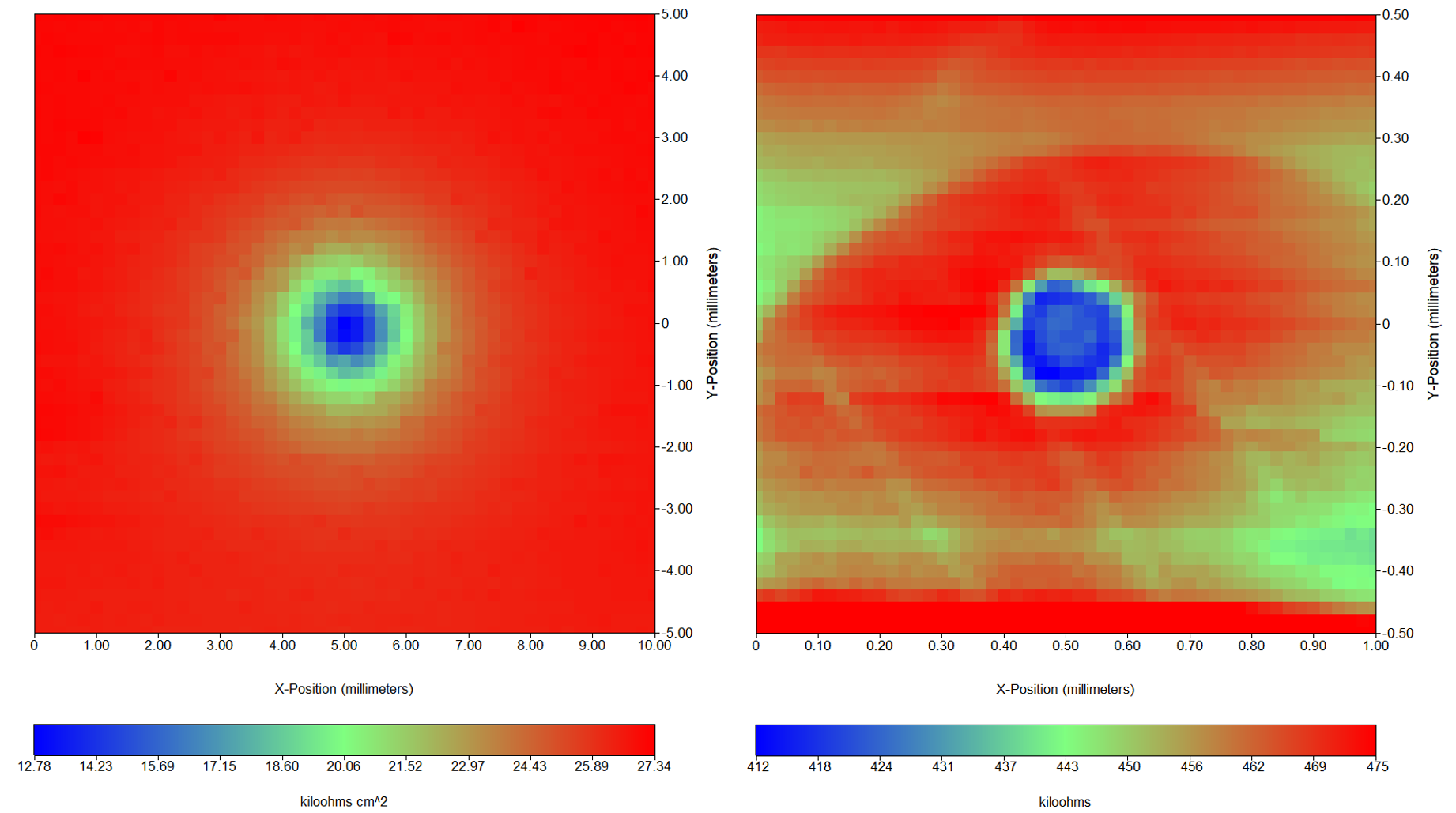LEIS or ac-SECM?
Latest updated: June 2, 2023Introduction
While bulk Electrochemical Impedance Spectroscopy (EIS) measurements are invaluable for a number of fields, they are limited in that they only provide an average measurement of the system. While local data can be obtained, this needs to be determined through sometimes complex analysis. When investigating a heterogenous sample, made up of a variety of features, it can be of great benefit in understanding the system to be able to locally measure the EIS, to determine the full effect of different features. This is where local impedance techniques, like Local Electrochemical Impedance Spectroscopy (LEIS), and Alternating Current – Scanning Electrochemical Microscopy (ac-SECM), have great benefit. With LEIS and ac-SECM it is possible to measure the local impedance of a system and directly visualize the effects local features have.
In LEIS an ac bias is applied between the sample and the reference electrode, which causes an ac signal to flow between the sample and the counter electrode. The result of this is an ac potential drop in the solution parallel to the sample surface. Using a bi-electrode probe it is possible to measure the potential difference at two heights above the sample surface, to determine the sample impedance. A schematic of the LEIS setup is shown in Fig. 1. On the other hand, in ac-SECM an ac bias is applied to the probe. When the probe is near the sample surface the electric nature of the sample influences the impedance measured by the probe. A schematic of the ac-SECM setup is shown in Fig. 2.

Figure 1: Schematic of the LEIS measurement. R is the resistance of the solution thickness between the two electrodes of the probe, and ΔEloc is the local ac potential difference measured by the bi-electrode. These values are used in the calculation of the local impedance Zloc

Figure 2 : Schematic of the ac-SECM measurement.
LEIS vs. ac-SECM
Both ac-SECM and LEIS measure analogous data, and furthermore LEIS is often used as a catchall term for any technique measuring local impedance data [1-3], therefore we are often asked to explain the differences between these two techniques.
There are a number of notable differences between LEIS and ac-SECM. In LEIS the sample is connected as a working electrode in a 5-electrode cell which includes the bi-electrode probe. As the working electrode the ac bias is applied directly to the sample, while the probe measures the effect of this it does not take part in any of the electrochemical processes. In ac-SECM, however, a 3-electrode cell is used, which the sample is not part of, instead the ac bias is applied to the probe. Typically, the ac-SECM sample is not even connected as a working electrode, and therefore samples ranging from fully conducting to fully insulating materials are suitable for measurement. This is contrary to LEIS, where, because the sample is a working electrode, it must be conductive – though it can be a coated sample. While the requirement that the sample will act as the working electrode in LEIS can limit its applicability, it allows LEIS to be a quantitative analysis, while ac-SECM is a qualitative analysis. In both LEIS and ac-SECM the probe defines the final measurement resolution of the two techniques. With smaller commercial probes available for ac-SECM, than LEIS, this offers it a particular advantage, although LEIS is more suitable for larger area measurements as a result. The comparison between LEIS and ac-SECM is summarized in the table below.
|
LEIS |
ac-SECM |
| Resolution determined by diameter of both probe electrodes, and distance between them | Resolution determined by probe diameter |
| mm scale resolution | µm scale resolution |
| Larger typical scan area | Smaller typical scan area |
| 5-electrode cell | 3- or 4- electrode cell |
| Sample is the working electrode | Probe is the working electrode* |
| EIS performed at the sample | EIS performed at the probe |
| Fully conducting and coated samples | Fully conducting to fully insulating samples |
| Quantitative analysis | Qualitative analysis |
| Commonly performed in galvanostatic mode | Commonly performed in potentiostatic mode |
| Constant height measurement | Constant height or constant distance measurement (when ic-SECM included) |
| Probe is visually positioned near the sample |
Probe is positioned near the sample by approach curve |
*In the less common direct mode measurements the ac-SECM probe is used as a counter electrode.
LEIS and ac-SECM are practically compared by the measurement of the same 200 µm Au Point-In-Space (PIS) sample in tap water, Fig. 3. For the LEIS measurement the PIS was measured in galvanostatic mode with an ac frequency of 5 kHz, an ac bias of 10 µA, and a dc bias of 0 A, applied at the PIS working electrode. The ac-SECM measurement was performed in potentiostatic mode with an ac frequency of 50 kHz, an ac bias of 100 mV, and a dc bias of 0 V vs. OCP applied at the 10 µm probe working electrode. Although both clearly show a low impedance region over the PIS, there are a number of notable differences in the resulting impedance maps. The LEIS measurement was performed over a larger area with a larger step size than the ac-SECM experiment. There is a noticeable difference in the FWHM of the peak due to the PIS, which is ~1.75 mm in the LEIS measurement, and ~205 µm in the ac-SECM measurement. There is a noticeable contribution from topography in the ac-SECM measurement with inhomogeneity appearing in the high impedance region over the resin. Notice also the difference in units for the measurements, with LEIS measured in kΩ cm2, while ac-SECM is measured in kΩ.

Figure 3 : Left: LEIS measurement of 200 µm Au PIS in tap water measured with an ac frequency of 5 kHz, an ac
bias of 10 µA, and a dc bias of 0 A. Right: ac-SECM measurement of 200 µm Au PIS in tap water measured
with an ac frequency of 50 kHz, an ac bias of 100 mV, and a dc bias of 0 V vs OCP.
Please see SCAN-Lab Technical Note 12 for further comparison of LEIS and ac-SECM.
References
- M. Lucas, J.-F. Boily, J. Phys. Chem. C, 121 (2017) 27976-27982
- W. Hassel. A. I. Mardare, J. Electroanal. Chem., 737 (2015) 93-99
- O. Gharbi, K. Ngo, M. Turmine, V. Vivier, Curr. Opin. Electrochem., 20 (2020) 1-7
Related products